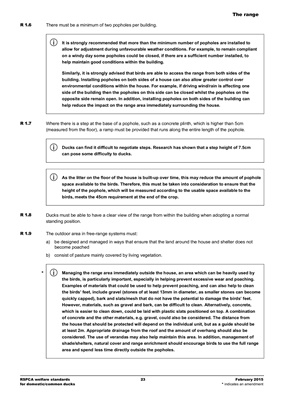
The range
RSPCA welfare standards
for domestic/common ducks
23 February 2015
* indicates an amendment
R 1.6 There must be a minimum of two popholes per building.
It is strongly recommended that more than the minimum number of popholes are installed to
allow for adjustment during unfavourable weather conditions. For example, to remain compliant
on a windy day some popholes could be closed, if there are a sufficient number installed, to
help maintain good conditions within the building.
Similarly, it is strongly advised that birds are able to access the range from both sides of the
building. Installing popholes on both sides of a house can also allow greater control over
environmental conditions within the house. For example, if driving wind/rain is affecting one
side of the building then the popholes on this side can be closed whilst the popholes on the
opposite side remain open. In addition, installing popholes on both sides of the building can
help reduce the impact on the range area immediately surrounding the house.
R 1.7 Where there is a step at the base of a pophole, such as a concrete plinth, which is higher than 5cm
(measured from the floor), a ramp must be provided that runs along the entire length of the pophole.
Ducks can find it difficult to negotiate steps. Research has shown that a step height of 7.5cm
can pose some difficulty to ducks.
As the litter on the floor of the house is built-up over time, this may reduce the amount of pophole
space available to the birds. Therefore, this must be taken into consideration to ensure that the
height of the pophole, which will be measured according to the usable space available to the
birds, meets the 45cm requirement at the end of the crop.
R 1.8 Ducks must be able to have a clear view of the range from within the building when adopting a normal
standing position.
R 1.9 The outdoor area in free-range systems must:
a) be designed and managed in ways that ensure that the land around the house and shelter does not
become poached
b) consist of pasture mainly covered by living vegetation.
*
Managing the range area immediately outside the house, an area which can be heavily used by
the birds, is particularly important, especially in helping prevent excessive wear and poaching.
Examples of materials that could be used to help prevent poaching, and can also help to clean
the birds' feet, include gravel (stones of at least 13mm in diameter, as smaller stones can become
quickly capped), bark and slats/mesh that do not have the potential to damage the birds' feet.
However, materials, such as gravel and bark, can be difficult to clean. Alternatively, concrete,
which is easier to clean down, could be laid with plastic slats positioned on top. A combination
of concrete and the other materials, e.g. gravel, could also be considered. The distance from
the house that should be protected will depend on the individual unit, but as a guide should be
at least 2m. Appropriate drainage from the roof and the amount of overhang should also be
considered. The use of verandas may also help maintain this area. In addition, management of
shade/shelters, natural cover and range enrichment should encourage birds to use the full range
area and spend less time directly outside the popholes.